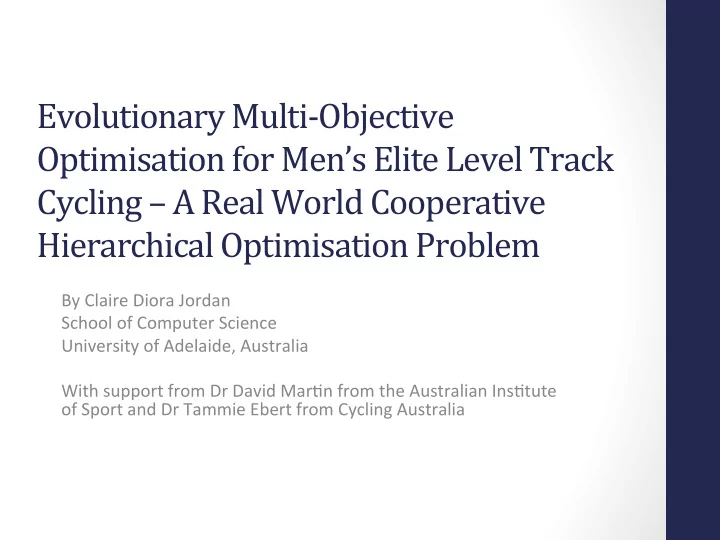

Evolutionary ¡Multi-‑Objective ¡ Optimisation ¡for ¡Men’s ¡Elite ¡Level ¡Track ¡ Cycling ¡– ¡A ¡Real ¡World ¡Cooperative ¡ Hierarchical ¡Optimisation ¡Problem ¡ By ¡Claire ¡Diora ¡Jordan ¡ School ¡of ¡Computer ¡Science ¡ University ¡of ¡Adelaide, ¡Australia ¡ ¡ With ¡support ¡from ¡Dr ¡David ¡Mar>n ¡from ¡the ¡Australian ¡Ins>tute ¡ of ¡Sport ¡and ¡Dr ¡Tammie ¡Ebert ¡from ¡Cycling ¡Australia ¡
Intro ¡ • Aim: ¡To ¡model ¡and ¡op>mize ¡strategies ¡for ¡Men’s ¡Team ¡Pursuit ¡ Cycling ¡Event. ¡ • Problem ¡is ¡difficult ¡as ¡it ¡involves ¡mul>-‑objec>ve ¡hierarchical ¡ solu>ons ¡spread ¡over ¡a ¡mul>modal ¡solu>on ¡space. ¡ • Significant ¡as ¡it ¡links ¡between ¡EC ¡theory ¡and ¡real ¡world ¡ problems. ¡
Men’s ¡Team ¡Pursuit ¡Track ¡Cycling ¡ • 4 ¡riders ¡around ¡a ¡velodrome. ¡ • Lead ¡rider ¡exerts ¡more ¡energy ¡while ¡ following ¡riders ¡get ¡the ¡benefit ¡of ¡slip ¡ streaming. ¡ • To ¡expend ¡maximum ¡energy ¡lead ¡rider ¡ changes ¡– ¡this ¡is ¡the ¡transi>on ¡strategy. ¡ • Each ¡rider ¡uses ¡an ¡amount ¡of ¡power ¡on ¡ each ¡half ¡lap ¡– ¡this ¡is ¡the ¡pacing ¡strategy. ¡ • Only ¡3 ¡of ¡the ¡4 ¡riders ¡are ¡required ¡to ¡finish ¡ – ¡adds ¡complexity ¡to ¡the ¡problem. ¡
Problem ¡Formulation ¡ • Have ¡2 ¡core ¡parameters ¡that ¡make ¡up ¡the ¡strategy: ¡ • Transi>on ¡Strategy ¡– ¡The ¡number ¡of ¡half ¡laps ¡before ¡ transi>oning ¡-‑ ¡discrete ¡ • Pacing ¡Strategy ¡– ¡The ¡power ¡output ¡of ¡the ¡front ¡rider ¡per ¡half ¡ lap ¡– ¡con>nuous ¡ HL 1 HL 2 ... HL m P 1 P 2 ... P n
Fitness ¡Function ¡ • Aim ¡is ¡to ¡minimize ¡the ¡>me ¡of ¡a ¡race. ¡ • Use ¡a ¡forward ¡integra>on ¡technique ¡to ¡simulate ¡the ¡>me ¡and ¡ energy ¡used ¡by ¡the ¡first ¡rider ¡to ¡ride ¡a ¡half ¡lap. ¡ ¡ • Find ¡power ¡taken ¡for ¡following ¡riders ¡to ¡keep ¡up ¡with ¡the ¡first ¡ rider. ¡ • Penalty ¡func>on ¡if ¡2 ¡or ¡more ¡riders ¡run ¡out ¡of ¡energy. ¡
Multi-‑Objective ¡ • Aim ¡of ¡op>miza>on: ¡ • Minimize ¡the ¡race ¡>me ¡ • Maximize ¡the ¡remaining ¡energy ¡ • Limited ¡research ¡has ¡been ¡done ¡in ¡the ¡area ¡of ¡hierarchical ¡ mul>-‑objec>ve ¡op>miza>on ¡problems ¡– ¡both ¡in ¡theore>cal ¡ and ¡prac>cal ¡domain ¡
Operators ¡ • 2 ¡halves ¡of ¡the ¡problem ¡that ¡require ¡different ¡types ¡of ¡ operators. ¡ • Discrete ¡Transi>on ¡Strategy ¡ • Random ¡muta>on ¡ • Creep ¡muta>on ¡ • Con>nuous ¡pacing ¡Strategy ¡ • Uniform ¡muta>on ¡ • Non-‑uniform ¡muta>on ¡ • Note: ¡Due ¡to ¡the ¡nature ¡of ¡the ¡problem ¡crossover ¡makes ¡no ¡ sense, ¡so ¡is ¡not ¡used. ¡
Basic ¡Approach ¡– ¡Single ¡Level ¡ • Non ¡problem ¡specific ¡technique ¡– ¡it ¡does ¡not ¡take ¡into ¡ account ¡the ¡hierarchical ¡nature ¡of ¡the ¡problem. ¡ • Mutates ¡solu>on ¡as ¡one ¡large ¡problem. ¡ HL 1 HL 2 ... HL m P 1 P 2 ... P n
Nested ¡Algorithm ¡ • Problem ¡has ¡2 ¡levels: ¡ • Leader ¡– ¡the ¡transi>on ¡strategy ¡ • Follower ¡– ¡the ¡pacing ¡strategy ¡ • Create ¡separate ¡EAs ¡for ¡the ¡leader ¡and ¡follower ¡problem ¡ ¡ • For ¡each ¡new ¡solu>on ¡to ¡the ¡leader ¡problem ¡op>mise ¡the ¡ follower ¡problem. ¡ ¡ ¡ • Combine ¡the ¡results ¡of ¡ Transitional Strategy both ¡EAs ¡to ¡get ¡the ¡parents ¡ Solution A for ¡the ¡next ¡genera>on ¡of ¡ the ¡leader ¡EA. ¡ Pacing Pacing Pacing Strategy Strategy ... Strategy Solution A Solution B Solution N
Nested ¡Algorithm ¡ • Algorithms ¡used ¡for ¡Leader ¡and ¡Follower: ¡ • NSGAII ¡– ¡established ¡algorithm ¡ • SPEAII ¡– ¡established ¡algorithm ¡ • MO-‑CMA-‑ES ¡– ¡established ¡algorithm ¡ • Found ¡these ¡explored ¡too ¡big ¡a ¡>me ¡range ¡so ¡introduced: ¡ • Greedy ¡– ¡given ¡a ¡set ¡of ¡λ ¡solu>ons, ¡selects ¡μ ¡solu>ons ¡with ¡ fastest ¡race ¡>mes ¡ • Greedy+Random ¡-‑ ¡given ¡a ¡set ¡of ¡λ ¡solu>ons, ¡selects ¡μ/2 ¡solu>ons ¡ with ¡fastest ¡race ¡>mes ¡and ¡μ/2 ¡solu>ons ¡randomly. ¡
Experimental ¡Design ¡ • Found ¡the ¡best ¡combina>on ¡of ¡operators ¡using ¡the ¡single ¡level ¡ op>misa>on ¡for ¡each ¡algorithm ¡ • To ¡compare ¡algorithms ¡a ¡fixed ¡number ¡of ¡evalua>ons ¡was ¡ used ¡– ¡2 ¡million ¡as ¡it ¡takes ¡approx. ¡3 ¡hours. ¡ • Created ¡a ¡realis>c ¡model ¡of ¡the ¡race ¡parameters ¡given ¡to ¡us ¡ by ¡the ¡Australian ¡Ins>tute ¡of ¡Sport. ¡
Results ¡ SPEAII-‑SPEAII ¡ Greedy+Random-‑SPEAII ¡ Time ¡ Energy ¡ Time ¡ Energy ¡ 251.76 ¡ 3482 ¡ 247.36 ¡ 1188 ¡ 260.84 ¡ 27749 ¡ 247.37 ¡ 2573 ¡ 270.82 ¡ 56294 ¡ 247.96 ¡ 3106 ¡ 280.14 ¡ 74175 ¡ 248.36 ¡ 5406 ¡ 295.74 ¡ 96226 ¡ 265.06 ¡ 35741 ¡ 312.84 ¡ 123248 ¡ 278.76 ¡ 64414 ¡ 323.34 ¡ 143810 ¡ 312.00 ¡ 122626 ¡ 334.52 ¡ 161780 ¡ 315.30 ¡ 126218 ¡ 363.64 ¡ 192034 ¡ 335.70 ¡ 161812 ¡ 384.66 ¡ 207959 ¡
Analysis ¡ • Preliminary ¡results ¡show ¡nested ¡approach ¡beher ¡than ¡ standard ¡approach. ¡ • Worse ¡>me ¡results ¡than ¡single ¡objec>ve ¡approach ¡-‑ ¡Increased ¡ diversity ¡of ¡mul>-‑objec>ve ¡approach ¡gives ¡too ¡much ¡emphasis ¡ to ¡remaining ¡energy ¡ • Need ¡to ¡further ¡explore ¡weigh>ngs ¡for ¡the ¡objec>ves ¡
Conclusion ¡ • Developed ¡and ¡applied ¡generalised ¡algorithms ¡to ¡a ¡real ¡life ¡ problem ¡ • Simplest ¡of ¡algorithms ¡s>ll ¡outperformed ¡unop>mised ¡ solu>on. ¡ • Preliminary ¡results ¡show ¡nested ¡approach ¡beher ¡than ¡ standard ¡approach. ¡ • Increased ¡diversity ¡of ¡mul>-‑objec>ve ¡approach ¡appears ¡to ¡be ¡ worse ¡than ¡single ¡objec>ve ¡approach. ¡ • Generalised ¡algorithms ¡proved ¡sufficient ¡for ¡our ¡domain ¡and ¡ can ¡be ¡applied ¡to ¡other ¡real ¡world ¡problems ¡in ¡the ¡future. ¡
Future ¡Work ¡ • Explore ¡weigh>ng ¡the ¡objec>ve ¡values ¡ • Development ¡of ¡more ¡efficient ¡algorithms ¡ ¡ • co-‑evolu>onary ¡algorithm ¡ • effect ¡of ¡inner ¡algorithm ¡ • Calibrate ¡results ¡with ¡real ¡cyclists. ¡ • Applica>on ¡to ¡other ¡real ¡life ¡problems. ¡
Questions? ¡
Recommend
More recommend